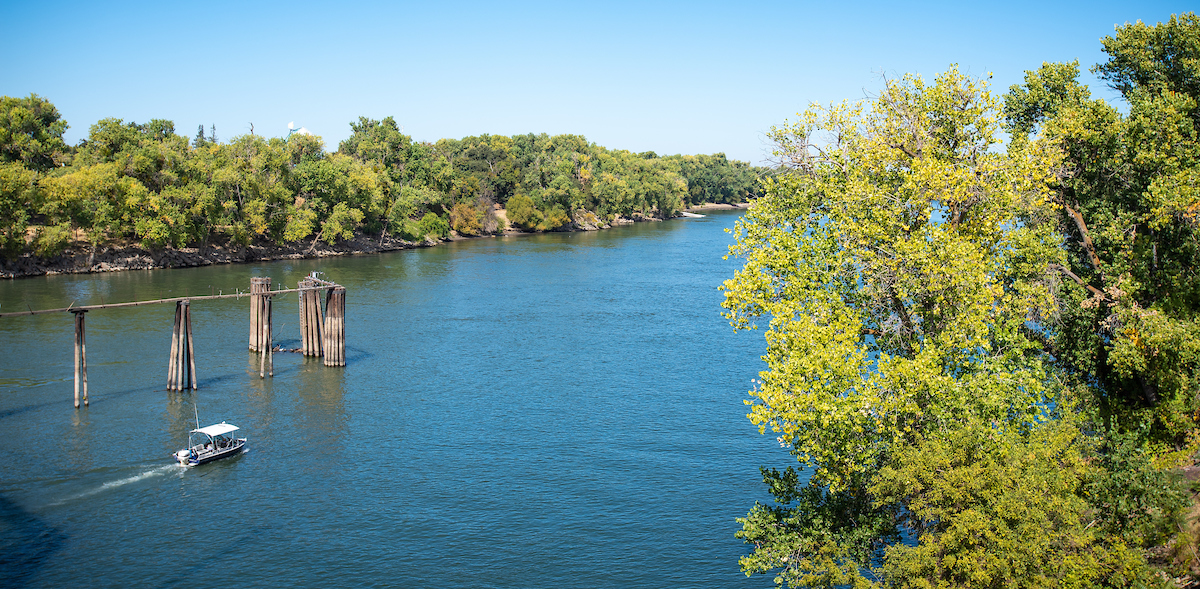A boat drifts up north the Sacramento River in Sacramento, California, during the afternoon of October 7, 2019.
SACRAMENTO, Calif. – This month six California and federal agencies representing water management, fish, and wildlife, along with the Sacramento River Settlement Contractors, signed onto the Sacramento River Science Partnership. The Partnership establishes an interagency science collaborative in which members will develop, share and discuss science to inform water management activities and protection of fish in the mainstem Sacramento River.
Stretching south from Shasta Lake, the largest reservoir in California, the Sacramento River carries water to millions of people at the same time it supports farms, birds along the Pacific Flyway, and endangered species, such as winter-run Chinook salmon. The seven signatories will foster and advance science to inform sustainable solutions to water management challenges including conflicts between water supply delivery and fish survival.
“By openly discussing science from their individual perspectives, the Members anticipate that opportunities to promote effective and efficient science may emerge,” the Partnership Charter says. Charter members include Bureau of Reclamation, Sacramento River Settlement Contractors, NOAA Fisheries’ West Coast Region and Southwest Fisheries Science Center, California Department of Fish and Wildlife, U.S. Fish and Wildlife Service, and California Department of Water Resources.
Partnership members are co-producing a science plan for the mainstem of the Sacramento River from Shasta Reservoir to Verona, at the confluence with the Feather River, including the Sutter Bypass. The plan, which is expected to be finalized in mid-September, provides science and research recommendations centered on prediction, detection and understanding of the effects of management actions designed to support all four runs of Sacramento River Chinook salmon.
The Partnership is coordinating with other groups working on water issues in the Sacramento River watershed and Central Valley salmon populations.
Officials say the diversity of the Partnership demonstrates its strength, because it draws on the expertise of local, state and federal partners. A shared understanding of research and monitoring, as well as collaborative science, will help build trust between agencies and stakeholders and provide a common foundation for decisions.
Statements from the Partners:
- “Reclamation looks forward to this new science collaborative. We welcome a forum that includes both stakeholders and agencies to reach a shared understanding of, and advancement in, the science supporting habitat restoration actions and our operation of Shasta Reservoir for fish, water supply, and power generation.”
-- Ernest Conant, Regional Director, US Bureau of Reclamation
- “The California Department of Fish and Wildlife is proud to be among the founding partners of this collaborative science effort to benefit one of California’s iconic rivers upon which so much of our state depends.”
-- Charlton H. Bonham, Director, California Department of Fish and Wildlife
- “DWR’s mission is to balance water supply and flood protection for communities while preserving species and natural ecosystems. We recognize the role of upstream tributaries in advancing this mission. The partnership brings together the right minds to preserve this critical upstream habitat.”
-- Karla Nemeth, Director, California Department of Water Resources
- “This takes advantage of shared resources to go beyond what any agency or organization would do on its own. We cannot recover these species on our own, and welcome partners to lean in and work through the science to inform good fish and water management decisions.”
-- Barry Thom, Regional Administrator, NOAA Fisheries’ West Coast Region
- “The partnership is a valuable forum for sharing and coordinating science that assists NOAA Fisheries with its responsibilities.”
-- Kristen Koch, Director, NOAA Southwest Fisheries Science Center
- “Science is the key to understanding how best to protect and manage fish and wildlife species. Water managers are best served when making decisions founded in solid and collaborative science. The Sacramento River Science Partnership is a great opportunity to move forward with development and sharing of that science.”
-- Paul Souza, California Great Basin Regional Director, U.S. Fish and Wildlife Service.
- “We have all seen that warring science only leads to conflict—this is a new path forward for collaborative science. It’s hard work, but this will help improve conditions for salmon while also serving water for farms, cities and rural communities, birds and recreation.”
-- Roger Cornwell, Chair, Sacramento River Settlement Contractors
###
Contacts:
Mary Lee Knecht, Bureau of Reclamation, (916) 978-5101, mknecht@usbr.gov
Peter Tira, CA Department of Fish and Wildlife, (916) 322-8908, peter.tira@wildlife.ca.gov
Ryan Endean, CA Department of Water Resources, (916) 653-9712, ryan.endean@water.ca.gov
Michael Milstein, NOAA Fisheries, (503) 231-6268, michael.milstein@noaa.gov
Pamela Bierce, U.S. Fish and Wildlife Service, (916) 414-6542, pamela_bierce@fws.gov
Thaddeus Bettner, Sacramento River Settlement Contractors, (530) 588-3450, tbettner@gcid.net
